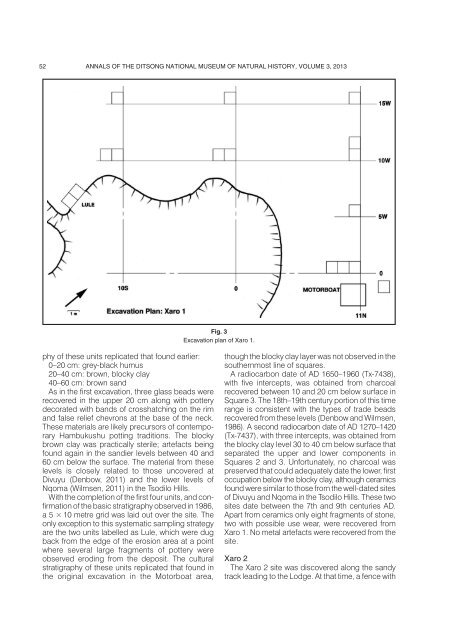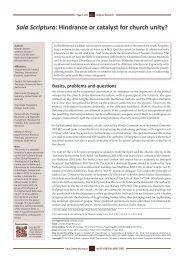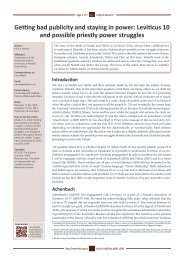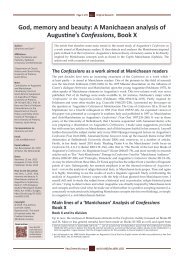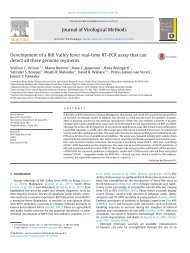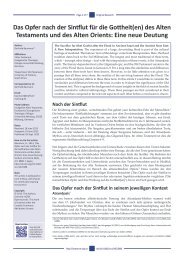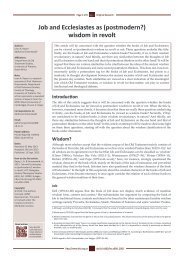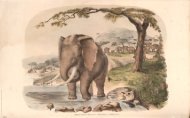View/Open - University of Pretoria
View/Open - University of Pretoria
View/Open - University of Pretoria
Create successful ePaper yourself
Turn your PDF publications into a flip-book with our unique Google optimized e-Paper software.
52 ANNALS OF THE DITSONG NATIONAL MUSEUM OF NATURAL HISTORY, VOLUME 3, 2013<br />
Fig. 3<br />
Excavation plan <strong>of</strong> Xaro 1.<br />
phy <strong>of</strong> these units replicated that found earlier:<br />
0–20 cm: grey-black humus<br />
20–40 cm: brown, blocky clay<br />
40–60 cm: brown sand<br />
As in the first excavation, three glass beads were<br />
recovered in the upper 20 cm along with pottery<br />
decorated with bands <strong>of</strong> crosshatching on the rim<br />
and false relief chevrons at the base <strong>of</strong> the neck.<br />
These materials are likely precursors <strong>of</strong> contemporary<br />
Hambukushu potting traditions. The blocky<br />
brown clay was practically sterile; artefacts being<br />
found again in the sandier levels between 40 and<br />
60 cm below the surface. The material from these<br />
levels is closely related to those uncovered at<br />
Divuyu (Denbow, 2011) and the lower levels <strong>of</strong><br />
Nqoma (Wilmsen, 2011) in the Tsodilo Hills.<br />
With the completion <strong>of</strong> the first four units, and confirmation<br />
<strong>of</strong> the basic stratigraphy observed in 1986,<br />
a 5 × 10 metre grid was laid out over the site. The<br />
only exception to this systematic sampling strategy<br />
are the two units labelled as Lule, which were dug<br />
back from the edge <strong>of</strong> the erosion area at a point<br />
where several large fragments <strong>of</strong> pottery were<br />
observed eroding from the deposit. The cultural<br />
stratigraphy <strong>of</strong> these units replicated that found in<br />
the original excavation in the Motorboat area,<br />
though the blocky clay layer was not observed in the<br />
southernmost line <strong>of</strong> squares.<br />
A radiocarbon date <strong>of</strong> AD 1650–1960 (Tx-7438),<br />
with five intercepts, was obtained from charcoal<br />
recovered between 10 and 20 cm below surface in<br />
Square 3. The 18th–19th century portion <strong>of</strong> this time<br />
range is consistent with the types <strong>of</strong> trade beads<br />
recovered from these levels (Denbow and Wilmsen,<br />
1986). A second radiocarbon date <strong>of</strong> AD 1270–1420<br />
(Tx-7437), with three intercepts, was obtained from<br />
the blocky clay level 30 to 40 cm below surface that<br />
separated the upper and lower components in<br />
Squares 2 and 3. Unfortunately, no charcoal was<br />
preserved that could adequately date the lower, first<br />
occupation below the blocky clay, although ceramics<br />
found were similar to those from the well-dated sites<br />
<strong>of</strong> Divuyu and Nqoma in the Tsodilo Hills. These two<br />
sites date between the 7th and 9th centuries AD.<br />
Apart from ceramics only eight fragments <strong>of</strong> stone,<br />
two with possible use wear, were recovered from<br />
Xaro 1. No metal artefacts were recovered from the<br />
site.<br />
Xaro 2<br />
The Xaro 2 site was discovered along the sandy<br />
track leading to the Lodge. At that time, a fence with


